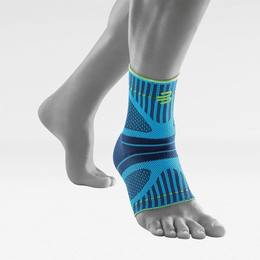Gear Up for the Long Run
What should your marathon training schedule include?
You have made your decision and probably even have registered: you got the date for your first marathon! Before your shoes hit the road, the trail or in the park, you should establish your individual marathon training schedule.
Many experts and running enthusiasts provide their personal schedules on the internet and explain what fits best to whom. Here, we have tried to encapsulate the most important training sessions. In general, it is a good idea to mix long, slow runs with shorter, faster ones and add enough rest and light training sessions for recovery. Shortly before the marathon itself, you should stick to tapering to be in top shape when standing at the starting line.
First, increase training...
The training volumes for a marathon are enormous. Even if you only want to finish, you should take at least about four hours per week, running about 30 miles. If your goals are higher, you should add another three to four hours and 25-30 miles per week, respectively.

The Base Run and The Long Run: The Base Run lays the foundations for your marathon because it provides you with the largest part of your training distance. During your training weeks, you should extend your runs until you almost reach the marathon distance (up to 20-26 miles). The speed here is rather slow and should be at least one to one-and-a-half minutes slower than your race speed. The heart rate during Base Runs should not be higher than 70-80% of your maximum heart rate.
The Long Run – as the long form of a Base Run – is important for improving your aerobic performance to show your body how to use its energy reserves efficiently. Only when your body knows how to use fat as an energy supply before using carbohydrates, will you be able to run long distances - like a marathon. Long Runs also train your cardiovascular system, improve the oxygen transport to the muscles and prepare your bones and tendons for the strain of a long-distance race. In short: No marathon without Base and Long Runs.
The Medium Long Run: covers distances from 5-10 miles, is faster than the Base Run and functions as a transition between the level of basic endurance and race performance. In medical terms: the exertion during the medium long run crosses the threshold between the aerobic and the anaerobic zone. In respect to what you really feel during your workout: you can still easily control your pace and could go even a bit faster if you wanted. Your heart rate should be at about 80-85% of the maximum. Some experts further distinguish an “easy” from a “speedy” Medium Long Run, with the latter being run at a slightly higher heart rate.
The Tempo Run: Tempo Runs are a part of several types of running such as intervals, fartleks, or progression runs (see below) but can also be a training session itself. The pace here is perceived as “comfortably hard”, i.e. a relatively fast pace that you can maintain for a long period, such as in a marathon. Some experts recommend a pace that is 10 to 25 seconds per kilometer slower than your current 10K race speed. Since the Tempo Run is a challenging training type (the heart rate can go up to 85-95% of the maximum), you should already have a certain basic endurance.
Competitive races over 10K and the Half Marathon: One of the nicest effects of your marathon training is that you will become faster over the shorter long distances as well. You usually get a good first impression of that during your competitions over 10 km (which you should schedule for week 2 or 3 during a 12-week marathon training) and the half marathon (at week 7). These runs are important self-assessments and help you find out your target time for the marathon. You shouldn’t go over but near your limit here. Use a pace you feel you could maintain for another two hours. Then go a bit faster. This helps you achieve a good time and gives you motivation for the marathon that’s still ahead.

The Recovery Run: The name says it all. Recovery Runs are all about recovering after a hard training session like an Interval or Tempo Run. It is also suitable for the three or four weeks after the marathon when you shouldn’t get back into your normal training routine, but help your body regain power and repair small muscle tears. Therefore, this run is the slowest of all your training runs at a very easy pace. Your heart rate shouldn’t be any higher than 65% of your maximum. Read more about Marathon Training Recovery.

The Interval Run: Interval Runs are not exactly what you would call a runner’s favorite, but nevertheless are an obligatory part of your marathon training. Over time they will significantly improve your race speed. Be careful, you should already have some running experience and basic endurance – you should be able to run non-stop for an hour – before starting these. Interval Runs put a lot of strain on your tendons, ligaments and muscles, and really challenge your cardiovascular system.
The idea of this kind of training is to alternate very fast and very slow sections for several times. The fast parts should be even faster than your recent 10K pace. A typical training session could look like this: a quarter-mile of slow warm-up, then a half-mile sprint, three to four minutes of jog trot, another half-mile sprint, jog-trotting again, etc. You may start with three or four repetitions in the first weeks and add a couple more over time.
Interval Runs are meant to take your body to a new level of running by repeatedly setting load peaks. You should generally run faster and increase your personal record over time. Since Interval Runs are usually rather short, you can include them into your working day training schedule without too much problem. A nice side effect of this kind of workout: due to the afterburn effect, you “incidentally” burn many calories even hours after the training.

If you think Interval Runs in their usual form are too rigid or exhausting, you can also include Fartleks into your marathon training schedule. At this workout, it totally is up to you when to increase speed and lower it again. You can adapt the tempo sections to your form on the day, your mood and the terrain. This gives you more freedom and you will benefit from the afterburn effect anyway.
Another special form of Interval Runs is the Pyramid Training. The setup here is comparable to the shape of a pyramid: in the first half, your fast sections become longer and longer, in the second, you gradually shorten them again. A typical Pyramid Running workout could look like this: 15 minutes of very easy warm-up, fast sections of 1-2-3-4-5-4-3-2-1 minutes, two-to-three minutes of jog trot between each fast section, and a cool-down of at least ten minutes after that.

...then stick to tapering

It is really important to massively lower your training volumes in the weeks directly before the marathon. This so-called "Tapering" begins about one month to two weeks before the race. Especially for marathon novices, it is recommended not to do long runs any more. Instead, short, intensive intervals or strides help you to stay fast and agile. Tapering helps your body to "actively recover". You can fully regenerate and heal from small injuries, e.g. micro tears in your muscular tissue, to be in top shape on race day.
Besides the hundreds of training miles, you definitely shouldn’t forget about the Basics of running. Regular Marathon Training Drills and a bit of strength training should be fixed parts of your marathon training schedule. Learn more about Marathon Training below.
Marathon training is multifaceted.
What would you like to learn more about?
What would you like to learn more about?









